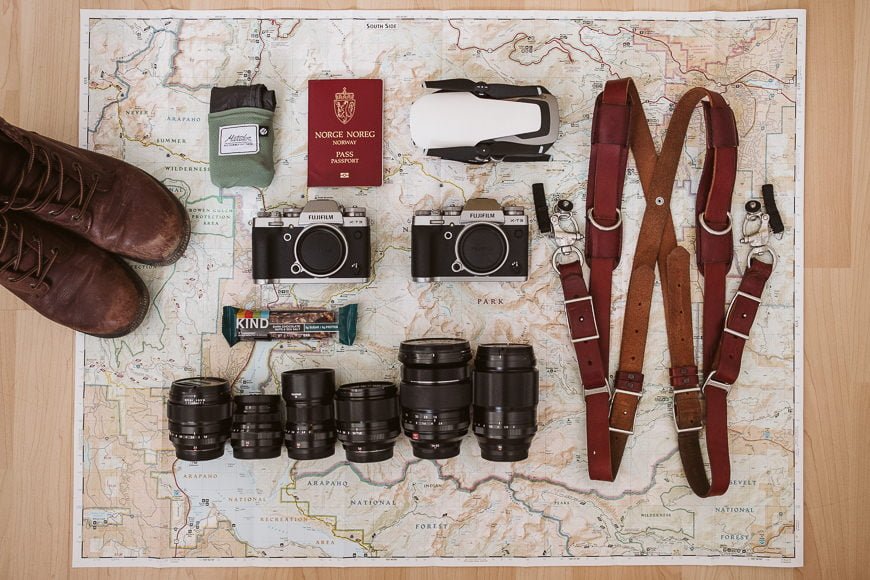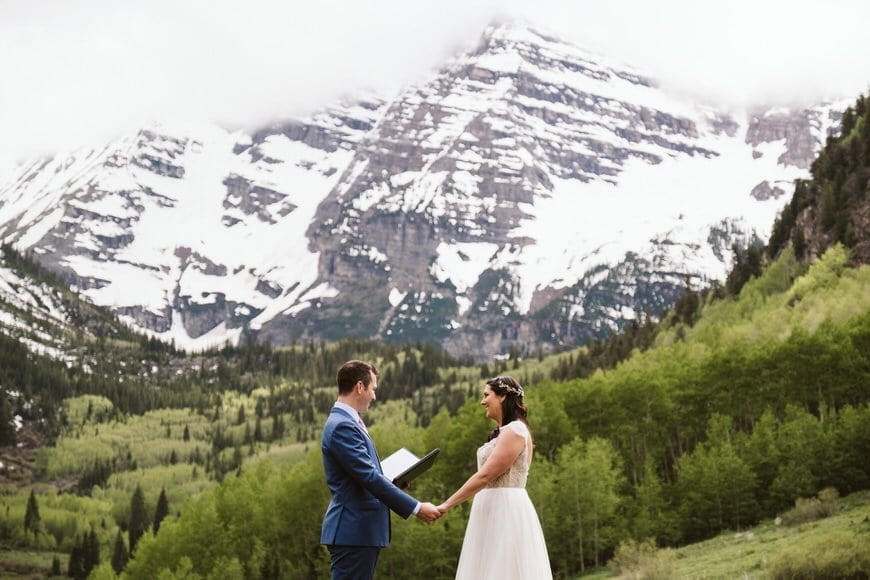







Nina Larsen Reed
Wedding | Last Updated: February 23, 2021
I’m Nina Larsen Reed, a wedding photographer based in Boulder and I specialize in photographing elopements and small weddings for couples across Colorado. I started my own business in 2013 after years as a hobbyist and I’ve been hiking, exploring, and taking photos full time since 2015.
I started out using Canon but after my first season of carrying two bodies around all day for weddings and hiking up mountains with 10+ lbs of gear I knew something had to change. I sold my whole Canon setup and invested in all new Fuji gear after doing some research on the different options for mirrorless cameras.
The first wedding I shot after switching I knew I had found the right gear for me. I finally felt like I could focus on what was happening in front of me and not what my gear was doing. With the electronic viewfinder on the Fuji X-T3, taking “test shots” was a thing of the past and my percentage of usable photos from each wedding skyrocketed.
Living and working in Colorado comes with its own set of unique challenges. It’s not uncommon to be caught outside in a hail storm on a sunny afternoon in July, or find yourself shooting in a blizzard in early October. I needed gear that could handle getting rained and snowed on, and the weather-sealed Fuji system delivered.
One of my fears when switching to mirrorless was that people would somehow take me less seriously as a photographer if I wasn’t using big DSLRs. Uncle Bobs and their comments about my “cute little cameras” aside, no one cares.
Since switching from Canon to Fuji, I spend less time messing around with settings. I don’t worry about going from below-freezing outdoors to taking photos in front of a roaring fireplace and my wrists and shoulders no longer hurt at the end of the day. What more could I ask for from my gear?
Cameras
Fuji X-T3 (x2) – I use these as my main camera bodies throughout a wedding day. I love how the small size lets me blend into crowds and get better candids without people noticing. I also love being able to shoot group portraits using the flip screen and live mode, so that I can keep the camera away from my face and give directions while making eye-contact.
Fuji X-T2 (x2) – These were my first Fuji bodies and now serve as my personal hiking and exploring cameras that I don’t have to worry about beating up.
Lenses
Fujifilm 16mm f/1.4 WR – This is my favorite lens for getting ready photos in small rooms, epic wide landscape shots in the mountains and night-time long exposures.
Fujifilm 23mm f/1.4 – This lens stays on one of my cameras 90% of the time.
Fujifilm 23mm f/2 WR – This lens used to be my main but after the 1.4 took over I’ve mostly used it for my own hikes and travels. It’s taken more than a few tumbles into snow and rocks, and is somehow still just as sharp as the day I got it.
Fujifilm 35mm f/1.4 – This lens is dreamy but almost never leaves my gear bag. I should probably change that.
Fujifilm 35mm f/2 R WR – Fuji’s equivalent of the nifty fifty! I mostly use it for engagement sessions and portraits where I don’t have to worry about going wide.
Fujifilm 50mm f/2 WR – More often than not, this is the lens I use on my second camera body throughout the day. It’s lightweight and small, the perfect sniper lens during cocktail hour and when I want to get candids of people without being noticed.
Fujifilm 56mm f/1.2 – A little slow to focus compared to the Fujifilm 50mm f/2 WR, but worth it for the prettiest bokeh in the Fuji line-up. I love this lens for portraits and any reception detail photos.
Fujifilm 90mm f/2 LM WR – This is my favorite lens for epic couples portraits in the mountains. The compression makes the peaks look even bigger and it really helps the couple pop against the background. I also always use this for the vow reading portion of ceremonies.
Fujifilm 16-55mm f/2.8 WR – I have shot a whole elopement on just this lens more than once. It’s weather-resistant and perfect for those days where it’s snowing so heavy that I can’t change my lenses while outside. I also prefer this lens when I only have one camera body out while hiking – you never know when you need that zoom to catch an elk crossing the trail in front of you!
Drone
DJI Mavic Air – I bought a drone thinking I would get so much use out of it but as I was studying for my pilot license I learned that 90% of the locations where I normally photograph elopements in the mountains don’t allow drones at all. For now I’m mostly using it when photographing weddings at venues that allow drones on their property and for my own personal travel photos.
Lights/Triggers
Godox V860II-F (x3) – I was tired of dealing with AA batteries so when I came across the Li-on Speedlights I was sold. I don’t often use flash and only carry one of these with me to elopements, but having three comes in handy for the few times a year where I photograph a traditional wedding dance floor.
Bags/Straps
ONA – The Bowery – My go-to bag for traditional weddings to easily carry an extra lens, batteries, memory cards and snacks around all day. It looks nice enough to not feel out of place if I have to drop it in a corner somewhere and is small and lightweight enough that I don’t hate myself at the end of the night.
– Fjällraven Kånken 15in – I wear this backpack for most of my shorter hiking elopements. The zip-front opening makes it easy to access both my gear and my snacks while on the move.
ThinkTank Airport Essentials – The perfect size for bringing all my gear to big weddings where I also need speedlights and also when traveling.
HoldFast MoneyMaker – I have gotten more compliments on this harness than any other piece of gear I own. When used with my Fujis and smaller lenses I can’t even feel that I’m carrying anything and my back thanks me for it every day.
BlackRapid Cross-Body Sling – I’ve had this thing since 2011 and it’s still my favorite way to carry a single camera. Great for both hiking up mountains and navigating the dance floor!
Tripods
Joby Gorillapod – The only tripod small enough to live in my hiking backpack. I sometimes use it for long exposure portraits by alpine lakes or at night but usually just for taking a selfie with each of my couples.
Hardware & Software
Lightroom – I do all my editing in Lightroom with my own presets made from a Mastin Labs base.
Táve – Táve runs my whole business and I don’t know how I’d manage anything without them. I love nerding out over ways to automate things so I can spend less time in front of my computer and more time in the mountains.
Misc.
Beyond my main gear I always carry an emergency kit with everything from sunscreen and bug spray to tweezers and ibuprofen (and snacks!) – when you’re miles away from civilization without cell service you can never be too prepared.
I also love my Matador Pocket Blanket. This thing takes up no space, yet folds out to a full-size water-resistant picnic blanket big enough for two people. It’s come in handy more times than I can count as a way to get couples down on the ground without worrying about getting their clothes dirty.
There’s this assumption that you need a huge variety of gear to be a successful photographer. If I was starting from scratch today I’d get two Fuji bodies, my three or four favorite lenses and call it good. The less I have to think about my gear, the more I can focus on the people and moments happening in front of me.
larsenphoto.co | @larsenphotoco

Check out these 8 essential tools to help you succeed as a professional photographer.
Includes limited-time discounts.












